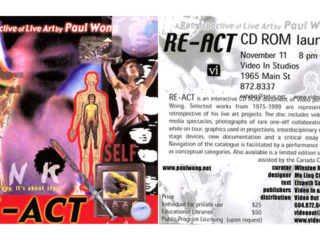SMASH: REFLECTING SEX
Smash: Reflecting Sex
Paul Wong, 2002
55 min, colour, stereo
“In 2002, I was invited to curate two video programs of Canadian works for EuroPride in Koln, Germany. Feeling disillusioned by the mainstreaming or “gay-streaming” of queer culture, I slammed together a collection of shorts critiquing our queer culture – an anti-Pride program. The second program was Smash: Reflecting Sex, an assemblage of video clips dealing with sex and sexuality by Paul Wong.
Wong’s videos rarely exhibit in queer festivals since most of his work is not explicitly gay but sexually ambiguous. Or as he says in an interview clip in the 80′s, “bisexuality is a viable option.” Now, for many of us, coming from the militancy of early 90′s identity politics and queer activism, bisexuality was seen as a cop-out. The term suggests that a person hasn’t fully come to terms with his or her sexuality or worse, a fence sitter – someone not to be trusted in our lavender revolution.
Fast-forwarding to the new millennium, I start to witness lesbians who identify as queer but sleep with men. Men who became women but sleep only with other women. People who wanted to be identified as gender-neutral – no more he/she, him or her, wanting others to refer to them simply as “Alex” or “Randy” although American states were sometimes allowed like “Dakota”. Meeting young people who thought that identifying oneself based on sexuality as pointless and narrow and the sexual fluidity of many people I know, who wake up sucking cock in the morning and are eating pussy by lunchtime.
I began to see Wong’s work not as sexually ambiguous anymore but as part of this new attitude where sexuality is not defined by identity or community but is acted upon, casually celebrated, permissible. Although his work is obviously influenced by 70’s sexual attitudes, revisiting this work seems uncannily current. It was these ideas along with wanting to frame Wong’s work within a queer context that “Smash” came to be.
Together, we decided to produce a new tape for the EuroPride screening as a collaboration between the artist and curator. After choosing all of Wong’s tapes dealing with sex and sexuality, plus his video performances, installations and televised interviews, we entered the editing room and decided to approach the material as if they were recently shot. By throwing out chronology, it freed us to re-assemble past footage into a new narrative – a sexual anthology of Wong’s work.
Segments from one tape like “Prime Cuts”(1981) were digitally altered and layered on top of the interviews from “Confused Sexual Views”(1984). “Ordinary Shadows/Chinese Shade”(1988) dissolves into “Born Under Surveillance”(1999). Wong’s 80s glam-spectacle performance, “Body Fluid”(1987) becomes a backdrop for his delightfully playful installation “Support Material”(1977).
A major focus is of course, “Confused” (1984) and the interviews from his banned installation “Confused Sexual Views” (1984). “Confused Sexual Views” was a 4-monitor installation consisting of 29 interviews with people talking candidly about sex for the Vancouver Art Gallery in 1984. Just three weeks before the opening, the VAG’s Director, Luke Rombout and Curator Joanne Birnie Danzker deemed the show contained “inappropriate content” and pulled the plug on the exhibition. A two-year court battle followed which the young artist recalled as “a fight for his life”. The infamous scandal galvanized artists and supporters across the nation and became a focal point for anti-censorship advocacy. Although Wong lost the court battle, the gallery ultimately mended it’s relationship with Wong in 2002 by purchasing several of his works including “Confused Sexual Views” and finally exhibiting the work.
Another tape of note is Wong’s first colour video, “60 Unit Bruise” (1976) made with fellow Vancouver artist, Ken Fletcher. A document of a performance, Fletcher withdraws 60 units of blood from his arms into a syringe and injects the blood into Wong’s back. Recently, Wong has revealed that although both men had girlfriends at that time, they were however secretly, lovers. Originally the work was seen a daring example of 70s body-art performance with it’s theme of blood ritual male-bonding and obvious nods to drug culture, but in today AIDS reality, it’s disconcerting viewing in our blood panic world.
Through his thirty years of work, Wong has explored numerous ideas. Never the one-note theme artist, he’s dealt with an array of ideas ranging from death, race, the body, and sexuality. Although unique as an artist/curator collaboration piece, “Smash” is not an anomaly in Wong’s body of work. In recent years, Wong has played several times with these “remixes”. During the first LIVE Performance Art Biennale (1999) in Vancouver, Wong produced a multimedia, 4 channel live projection of his past performances, entitled “Re/Act”. For the 2003 Extra 50 at the Venice Biennale, “Hungry Ghost” was a five-channel re-examination of his videos dealing with death or “death works” mixed with new footage projected within a moving vaporetto (water bus) en route through the canals of Venice.
Wong has been constantly, some would say, obsessively videotaping himself, his friends and the world since he was a teenager. There ’s an insurmountable amount of material, which he has yet to use. These “remixes” serve not just as artistic self-reflection, but a way to utilized unseen and rare footage, mixing it with older works into “new” material. The remixes becomes a vehicle also for Wong to reach younger and new audiences unfamiliar with his past works and for those familiar with his material, a chance to see his older works as something new.
Smash contains (order of appearance): Born Under Surveillance (1999), Body Fluid (1987), “4”(1978-1980), So Are You (1994), Confused Sexual Views (1984), Confused (1984), Confused Controversy (1986), Support Modeling (1977), Prime Cuts (1981), Blending Milk & Water: Sex in the New World (1996), Ordinary Shadows/Chinese Shade (1988), Wah-Q (1998), 60 Unit Bruise (1976).”
-Winston Xin, Art Star 3 Video Art Biennial, Published by Galerie Saw Video 2007
Distributed by Paul Wong Projects


